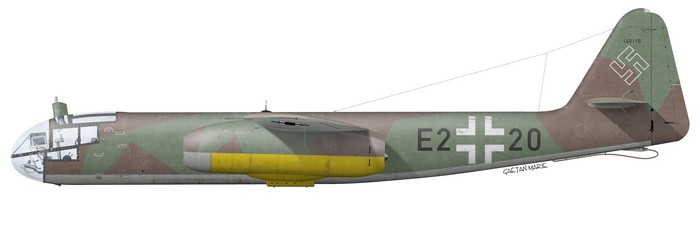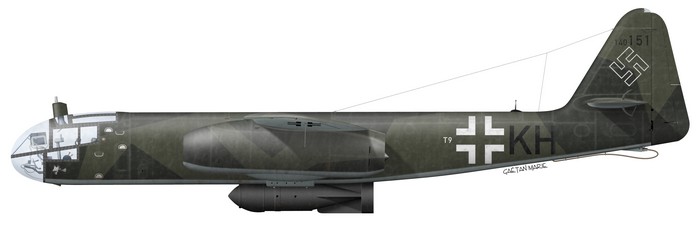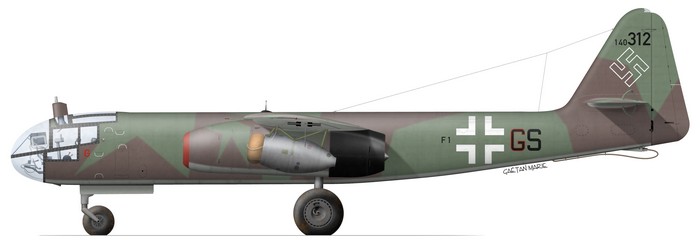The Ar 234 Blitz was the world’s first operational jet bomber. Despite being used in limited numbers, it proved to be a successful design, being the only attack/bombing/reconnaissance type capable of surviving in the midst of Allied air superiority in 1944-45.

1. Ar 234 S10 (Wk. Nr. 140110) used by Erprobungskommando 234 at Rechlin-Lärz in November 1944. This aircraft was used to test the Hs 293 anti-ship missile and its associated FuG 203 radio guidance system.
 2. This aircraft was used by Kommando Sperling (Sparrow) in late 1944 and was flown by Oberleutnant Werner Muffey. The nose art represents a farting sparrow and was present on all aircraft belonging to Kommando Sperling.
2. This aircraft was used by Kommando Sperling (Sparrow) in late 1944 and was flown by Oberleutnant Werner Muffey. The nose art represents a farting sparrow and was present on all aircraft belonging to Kommando Sperling.
 3. “Snafu I” was one of four Arado 234 sent to the US for evaluation and testing. Its original Werk Nummer is probably 140148, although some sources indicate 140343. It was acquired by the British at Sola airfield, near Stavanger in Norway, by “Watson’s Whizzers”, a group of American pilots whose mission was to secure German jets, under the command of Col. “Hal” Watson. The aircraft was flown from Sola to Grove, UK and then Melun, France where it was loaded on HMS Reaper and sent to the US. It was tested by the US Navy at Patuxent River NAS. However, it was not flown due to lack of spare parts and only used in ground tests. It was discarded by the Navy in the 1950s.
3. “Snafu I” was one of four Arado 234 sent to the US for evaluation and testing. Its original Werk Nummer is probably 140148, although some sources indicate 140343. It was acquired by the British at Sola airfield, near Stavanger in Norway, by “Watson’s Whizzers”, a group of American pilots whose mission was to secure German jets, under the command of Col. “Hal” Watson. The aircraft was flown from Sola to Grove, UK and then Melun, France where it was loaded on HMS Reaper and sent to the US. It was tested by the US Navy at Patuxent River NAS. However, it was not flown due to lack of spare parts and only used in ground tests. It was discarded by the Navy in the 1950s.
 4. 140312 is the only surviving Ar 234 in the world today. It is a Ar 234B-2 bomber that was operated by 9./KG 76 and was surrendered to British forces at Sola Airfield in Norway in the final moments of the war. It was shipped to the US where it was reassembled and test-flown at Wright Field near Dayton until July 1946, under foreign equipment number FE-1010. In 1949 it was transferred to the Smithonian Institution and remained in storage for many years, until it was restored in 1989 and painted with the colours of an aircraft from 8./KG 76. It is now on display at the Udvar-Hazy Center near Washington, D.C.
4. 140312 is the only surviving Ar 234 in the world today. It is a Ar 234B-2 bomber that was operated by 9./KG 76 and was surrendered to British forces at Sola Airfield in Norway in the final moments of the war. It was shipped to the US where it was reassembled and test-flown at Wright Field near Dayton until July 1946, under foreign equipment number FE-1010. In 1949 it was transferred to the Smithonian Institution and remained in storage for many years, until it was restored in 1989 and painted with the colours of an aircraft from 8./KG 76. It is now on display at the Udvar-Hazy Center near Washington, D.C.
